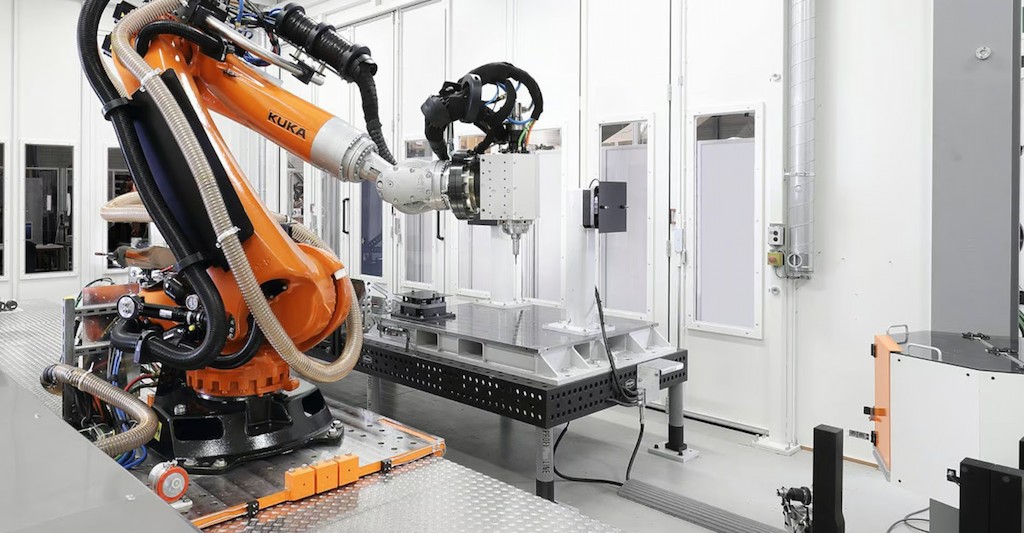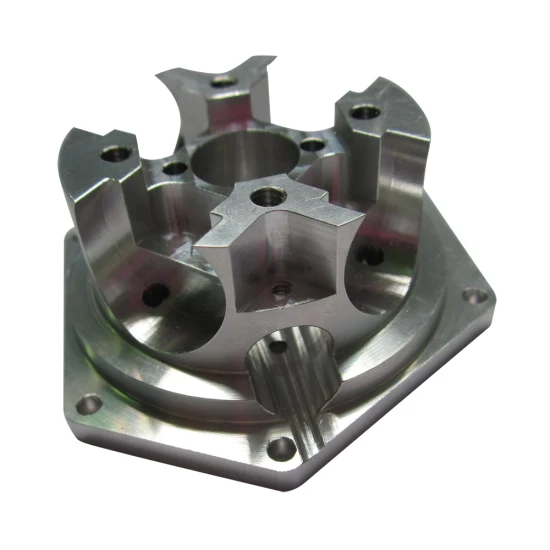“CNC robotics machining enables complex and repetitive tasks to be performed with unmatched accuracy and efficiency. This integration streamlines production processes and enhances manufacturing capabilities.”

As demand for precise and accurate parts is increasing across industries, machining technology is continuously witnessing new automation cnc machines and robotics. Machining robotics enhances the precision, speed, and capability of handling complex designs of typical CNC Machining Proces. The robotic machining is carried out by controlling the robot path and machining tool center. Often, it may include robotic arms or other similar mechanism.
A machining or milling robot can execute various machining operations simultaneously in one go, cutting, drilling, tapping, grinding, etc. In this article, we will discuss the working, machining capabilities, advantages, applications, and other aspects of robotic machining.
What is Machining Robotics?
It is the process of automatically shaping the workpiece using robotic arms equipped with cutting tools. The arms typically clamp multiple cutting tools required to shape the workpiece into the final shape and size. For example, milling, drilling, reaming, deburring, etc. Moreover, machining robotics uses various additional features compared to a typical CNC machining process. It can adjust the process in real time, send feedback to the control panel, and perform initial quality control itself.

Robotics arm performing machining
Furthermore, machining robotics also uses CAM or other similar software to find the tool path and generate instructions that a machining robot can understand. The flexibility, precision, correct tool positioning, adaptive control for consistency, and the possibility of translating more complex designs are making it increasingly popular in manufacturing.
If we compare CNC Machining Tolerance with robotic machining precision, the robotic arm can maintain a tolerance of less than 100 μm easily.
Here are the general steps on how robotic machining works;
- Robotic Machine Tool Setup: Select a suitable robotic tool to attach to the spindle. Then, mount the workpiece securely on a fixture.
- Alignment and Positioning: Align the robot axes using a dial test indicator (DTI) and laser tracker. You must ensure parallelism, squareness, and accurate coordinate system setup.
- Machining Test Geometry: Choose suitable workpiece materials and test artifacts to assess the robot’s performance across various geometries.
- Tooling and Parameter Selection: Select appropriate tools, calibrate the tool center point, and optimize cutting parameters using computer modeling.
- CAM Programming and Execution: Plan and simulate tool paths using CAM software. Then, convert programs to robot-specific format and execute the machining process.
Try Prolean Now!
Are Machining Robotics and CNC Robotics Same?
They are similar but not identical. CNC robotics refers to machines controlled by computer numerical control (CNC) systems. These systems are typically rigid and designed for specific tasks like milling, turning, or drilling.
On the other hand, machining robotics involves using robotic arms or other mechanism for material removal processes. Although they perform similar machining tasks, the flexibility of reprogramming and multiple operations is higher. Additionally, robotic machining can also perform operations in complex or hard-to-reach areas.
Advantages of Robotics Machining
The automation cnc machines and robotics integration offer several advantages regarding productivity, precision, consistency, reliability, and opportunity for innovations. Here is a brief of key machining robotics advantages;
High Productivity
The milling robot or any CNC robotics offers more output than conventional CNC machining centers. The reduced machining downtime, production cycle time, and capability of handling multiple operations significantly increase overall productivity.
Consistent Quality
Since it reduces the human intervention in the process, it maintains the same quality across the production batches. Machining robotics can also record and analyze the previous batches to achieve consistency. Additionally, it also reduces the deviations in work holding, tool alignment, centering, etc.
Reliability
CNC robotic systems or machines do not need frequent maintenance and replacement of components. There is no such thing as shaft changes and fatigue breaks. Therefore, it is a more reliable system.
Small Space Footprint
Unlike CNC machining setup, machining robotics does not need a larger working area, The compact structure and tooling setup of the machining robot significantly reduce the size to operate. It could be beneficial to work with a large workpiece and manage the workspace.
Degrees of Freedom
CNC robotics and any specific machining robot have a higher degree of freedom. It means the machine or system has more movement freedom across the axes. It allows to crafting of more complex and intricate geometrical features.
Machining Robotics Applications

Robotic machined part
The applications of robotic machining are widespread across industries, whether it is assembly control in automotive, robotics milling of surgical guides and implants, or contouring of composite parts for aerospace. The table summarizes the key applications with examples;
| Industry | Why Use It? | Application Examples |
| Automotive Industry | It increases the production speed and provides higher accuracy, essential for the vehicle’s performance. | Engine components, transmission housings, body panels, etc. |
| Medical Industry | It offers high-precision manufacturing and intricate features | Prosthetic joints, dental implants, surgical instruments |
| Aerospace | Precise assembly, monitoring, manage complex shapes, and composite machining | Aircraft wing components, turbine blades, fuselage sections |
| Industrial Plants | Robotic streamline production processes, increase safety in industrial hazardous | Valves. pump housings, heavy machinery parts |
| Product Assembly | High accuracy and efficiency, real-time control, and monitoring. | Precision gear assemblies, electronic components, etc. |
Try Prolean Now!
Summing Up
Machining robotics offers higher movement freedom and highly automates the machining operations. Its several advanced features like handling multiple operations, repeatability, and production speed have made it popular in various critical applications. However, if you are outsourcing the service, the expertise of manufacturers equally influences the final result along with the machining robotics equipment they have.
Automatic Robotic Machining at Proleantech caters to aerospace, medical, automotive, industrial plants, and other industries to accurate parts and products. It is a leading company in the field of CNC Machining China services.
We have multi-axis CNC systems equipped with robotic arms, that can execute several machining operations. Our R & D team and production team closely work to handle complex and custom projects. If you need related CNC Machining Service, you can request a quote!
FAQs
What is meant by robotic machining?
It refers to the use of industrial robots equipped with machining tools to perform tasks like milling, drilling, and cutting.
When to use robotic machining?
You can use robotic machining for complex shapes, or processing large or awkwardly shaped parts.
Is robotic machining more expensive than CNC?
It can be more cost-effective than traditional CNC machines, especially for large, complex, or variable tasks. However, the initial investment could be high.
What are the examples of robotic machined parts?
Some examples of robotic machined parts include automotive engine components, aerospace turbine blades, carbon fiber aircraft sections, medical implants, etc.




0 Comments